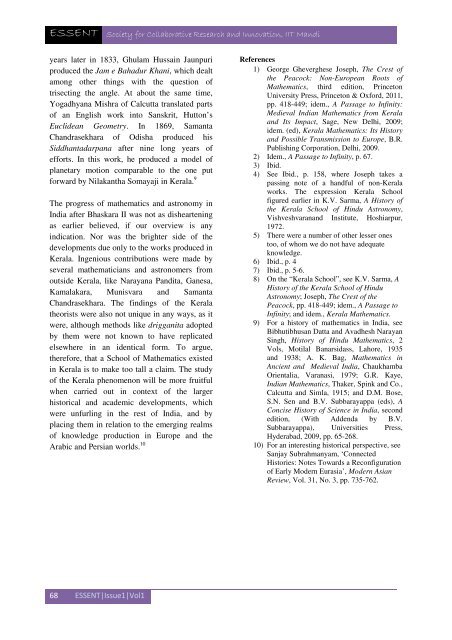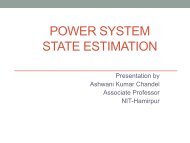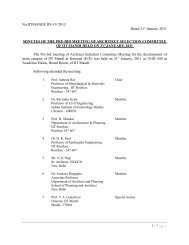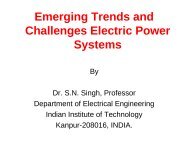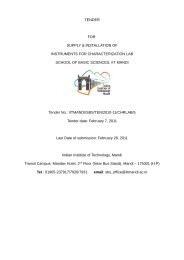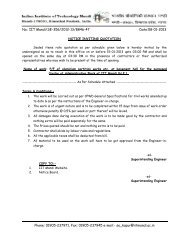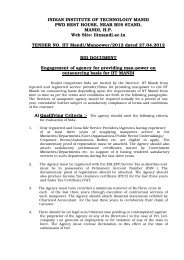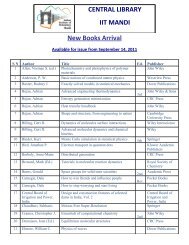Issue1. Vol.1 (April, 2013) - IIT Mandi
Issue1. Vol.1 (April, 2013) - IIT Mandi
Issue1. Vol.1 (April, 2013) - IIT Mandi
- No tags were found...
Create successful ePaper yourself
Turn your PDF publications into a flip-book with our unique Google optimized e-Paper software.
ESSENT Society for Collaborative Research and Innovation, <strong>IIT</strong> <strong>Mandi</strong>years later in 1833, Ghulam Hussain Jaunpuriproduced the Jam e Bahadur Khani, which dealtamong other things with the question oftrisecting the angle. At about the same time,Yogadhyana Mishra of Calcutta translated partsof an English work into Sanskrit, Hutton’sEuclidean Geometry. In 1869, SamantaChandrasekhara of Odisha produced hisSiddhantadarpana after nine long years ofefforts. In this work, he produced a model ofplanetary motion comparable to the one putforward by Nilakantha Somayaji in Kerala. 9The progress of mathematics and astronomy inIndia after Bhaskara II was not as dishearteningas earlier believed, if our overview is anyindication. Nor was the brighter side of thedevelopments due only to the works produced inKerala. Ingenious contributions were made byseveral mathematicians and astronomers fromoutside Kerala, like Narayana Pandita, Ganesa,Kamalakara, Munisvara and SamantaChandrasekhara. The findings of the Keralatheorists were also not unique in any ways, as itwere, although methods like drigganita adoptedby them were not known to have replicatedelsewhere in an identical form. To argue,therefore, that a School of Mathematics existedin Kerala is to make too tall a claim. The studyof the Kerala phenomenon will be more fruitfulwhen carried out in context of the largerhistorical and academic developments, whichwere unfurling in the rest of India, and byplacing them in relation to the emerging realmsof knowledge production in Europe and theArabic and Persian worlds. 10References1) George Gheverghese Joseph, The Crest ofthe Peacock: Non-European Roots ofMathematics, third edition, PrincetonUniversity Press, Princeton & Oxford, 2011,pp. 418-449; idem., A Passage to Infinity:Medieval Indian Mathematics from Keralaand Its Impact, Sage, New Delhi, 2009;idem. (ed), Kerala Mathematics: Its Historyand Possible Transmission to Europe, B.R.Publishing Corporation, Delhi, 2009.2) Idem., A Passage to Infinity, p. 67.3) Ibid.4) See Ibid., p. 158, where Joseph takes apassing note of a handful of non-Keralaworks. The expression Kerala Schoolfigured earlier in K.V. Sarma, A History ofthe Kerala School of Hindu Astronomy,Vishveshvaranand Institute, Hoshiarpur,1972.5) There were a number of other lesser onestoo, of whom we do not have adequateknowledge.6) Ibid., p. 47) Ibid., p. 5-6.8) On the “Kerala School”, see K.V. Sarma, AHistory of the Kerala School of HinduAstronomy; Joseph, The Crest of thePeacock, pp. 418-449; idem., A Passage toInfinity; and idem., Kerala Mathematics.9) For a history of mathematics in India, seeBibhutibhusan Datta and Avadhesh NarayanSingh, History of Hindu Mathematics, 2Vols, Motilal Banarsidass, Lahore, 1935and 1938; A. K. Bag, Mathematics inAncient and Medieval India, ChaukhambaOrientalia, Varanasi, 1979; G.R. Kaye,Indian Mathematics, Thaker, Spink and Co.,Calcutta and Simla, 1915; and D.M. Bose,S.N. Sen and B.V. Subbarayappa (eds), AConcise History of Science in India, secondedition, (With Addenda by B.V.Subbarayappa), Universities Press,Hyderabad, 2009, pp. 65-268.10) For an interesting historical perspective, seeSanjay Subrahmanyam, ‘ConnectedHistories: Notes Towards a Reconfigurationof Early Modern Eurasia’, Modern AsianReview, Vol. 31, No. 3, pp. 735-762.68 ESSENT|Issue1|Vol1


